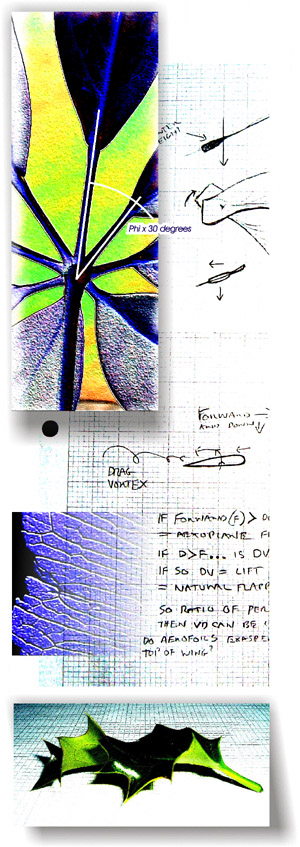|
IntroductionIn the 18th February 2006 issue of New Scientist, there was an article
by Tim Thwaites called, “Slippery ships float on thin air”. It focuses on research by Japan's National Maritime
Research Institute (NMRI) into reducing the friction between a ship’s hull and the water it travels through i.e. the
sea. Apparently the NMRI research is one of several similar initiatives by the
Americans, Russians and Europeans. It’s clearly being taken very seriously, and with good reason.
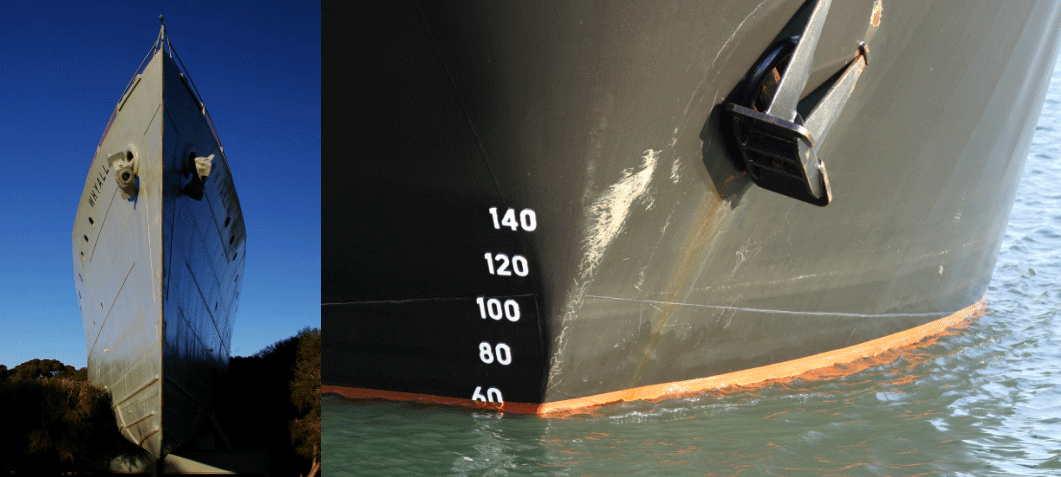
|
| Fig. Fs1. Ship hulls are designed to minimise water-hull friction (image copyright Fotolia.com) |
The potential gains for reducing the ‘water-hull’ friction (drag)
of ships are huge… Vessels can go further, go faster, use less fuel, carry more, and most importantly to me… Reduce
pollution. To put this in context, ‘Utne magazine’ estimates that a mere 10% increase in efficiency would equate to “savings of more than $4 billion industry-wide”(i.e.
the shipping industry)… Each year.
The idea highlighted in the New Scientist, article was based upon a design
that released millions of small air bubbles through small holes in the hull to create a kind of air cushion between the water
and the hull of the ship, thereby greatly reducing friction. The article mentions flicking a switch to create the millions
of tiny bubbles. It’s fair to say I don’t know very much about how the idea works from just reading the article,
but even so, it struck me that whilst “flicking a switch“ may be a simple act, it also appears to be applying
man-made energy to the problem which to me, is still part of the problem. However this idea is powered, and with respect
to those involved, I believe this is ‘solution-making’ the wrong way round. I think we should be looking at making
the design more efficient, not trying to compensate for its inefficiency.
After
reading the New Scientist article I felt compelled to look closer at nature’s design of a low friction waterborne object
- a fish - and in particular to see if I could understand how fish swim. The fairly obvious reasoning being that if
one can truly understand how fish swim, there should be some good clues for designing very efficient, environmentally friendly
water borne vessels… A trout for example, is so efficient that sometimes it can ‘stand still’ in fast
flowing water without using any of its own energy. It causes zero pollution, it’s been ‘road tested’
for millions of years and of course, is completely free of Intellectual Property rights... It has to be a good starting point!
As
mentioned in the intro I’d been studying nature for some time which had given me a great insight into how fish interact with water and the
behaviour of water itself. It wasn’t long after I started thinking about how fish swim in relation to the design of
ships, that I had a startling realisation that seemed to make complete sense. But, I needed to research the subject and see
what discoveries had been made already and then lay out my ideas so that they were readable: which I have tried to do here.
What followed was over a year of studying the latest research and investigating the subject of fish swimming. I didn’t
realise it would take me on such an in-depth journey!
The
Stationary Trout…
Viktor Schauberger had a habit of raising many simple but profoundly important issues like; ‘how does a trout manage to ‘stay
still’ in a fast flowing river?’ He observed that the occasional gentle sway of its tail is all that’s
needed to maintain its position in the flowing water. There is no argument here, anyone can observe this for themselves.
Make a noise from the riverbank however, and with a twist of its body, the trout darts away. The strange thing - and you can
check this for yourself as well - is that instead of escaping downstream (even though it would surely be easier and faster
to escape with the current?) almost every time they choose to escape upstream against the current, and they do so with the
speed of a mouse running for its life. If one stops and thinks for while, this is a remarkable swimming feat. I thought,
if we can understand how they do this, it would be invaluable in helping to reduce drag and design much more efficient ships,
and a lot more besides.
So
that begs the question: “how do fish swim?”
I
believe that the art of nature is a sublime, delicate balance of many subtle ‘design features’: so there won’t
be just one part to the answer. Fish employ many techniques when swimming but I believe that the commonly held view
- that the tail fin is the main thruster - is incorrect. As strange as it may sound, I believe the most important technique
is something completely different.
Although
my hypothesis is remarkably simple, there is a bit of flow dynamics and vortex theory that needs to be absorbed first.
For the layperson, good examples of vortices are when water swirls harmlessly round and down the plug-hole in a bath, or when
air swirls and generates one of the most powerful natural phenomena on the planet: a tornado...
Vortices
forming in flowing water…
There
are many papers publicly available on the internet as well as information in encyclopaedias and in the fantastic wikipedia explaining how vortices form behind stationary objects in flowing water. They’ve been (not particularly elegantly)
called a ‘Kármán Benard vortex street’, which I abbreviate to ‘vortex street’. Below is a simplified
diagram I’ve made showing the phenomenon. The stationary object could be almost anything – a good example in this
case is a rock in a river. As the water flows past the rock, it creates vortices behind the rock, alternately from one side
then the next, slowly loosing their strength as they drift downstream.
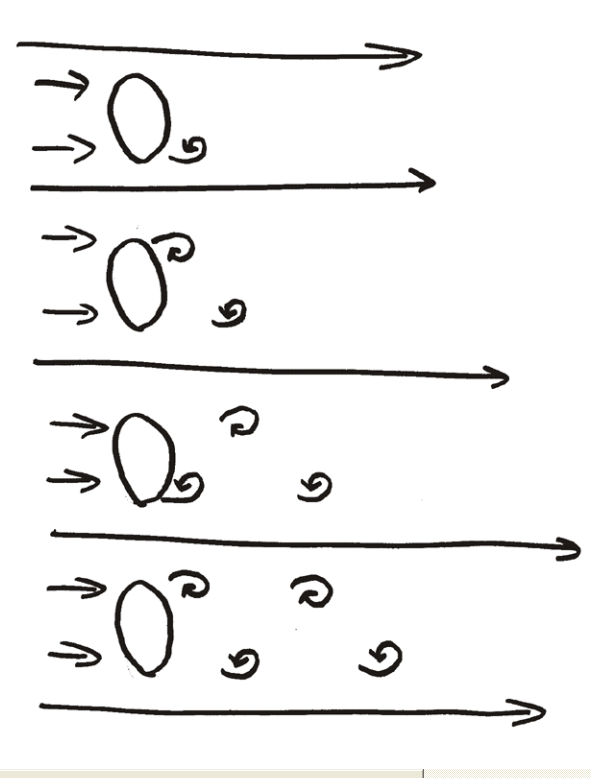
|
| Fig. Fs02. Vortices forming behind a rock in flowing water i.e. a vortex street |
Fish
exploit vortices in flowing water...
Now
it gets a bit more interesting… Back in March 1995, ‘Scientific American’ published a fascinating article
titled “An Efficient Swimming Machine” it focuses on detailed research into how fish swim and the results of tests of a mechanical fish that was built for
the purpose, nicknamed “RoboTuna”! Amongst many interesting discoveries, the research establishes that fish
somehow exploit vortices in water to help them swim.
Over
the years several research papers have been published about fish swimming. One that I found particularly interesting
is a paper by James C. Liao in 2004 which looks at muscle activity of a trout swimming in a vortex street. This paper and others surmise that fish
somehow exploit the vortices to reduce the amount of energy they need to combat the momentum of the flowing water. There
needs to be a relationship between the size of the fish, the size of the rock and the speed of the water flow for the conditions
to be right, but if they are, the fish can hold its position with very little effort. Apparently they do this by slaloming
between the vortices, synchronising their body movements to match the flow of the vortices.
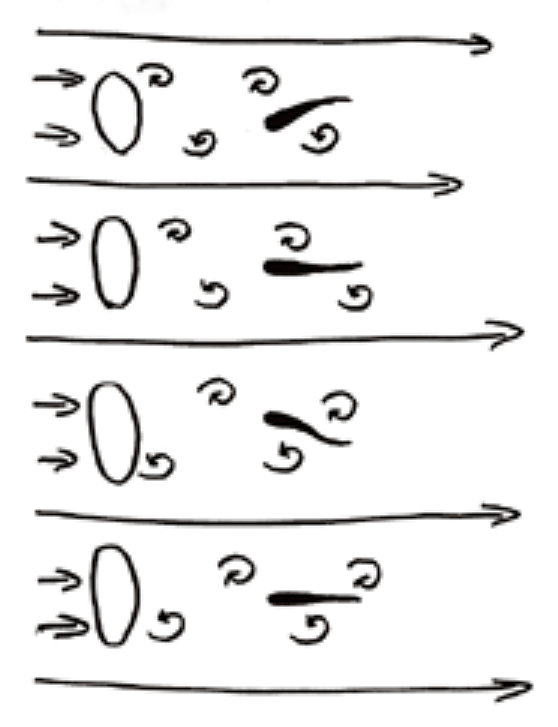
|
| Fig. Fs03. The illustration shows a trout slaloming between vortices in the vortex street. |
Pulling yourself up by your boot straps...
It’s clear from the research undertaken that fish somehow harvest energy from
vortices formed in water behind a stationary object, but it gets even more intriguing than that. It appears that if there are no useful vortices already formed in the water (e.g. by rocks etc) –
the trout can actually make some itself - and then extract energy from them... A very useful trick; the phrase “pulling
yourself up by your boot straps” springs to mind!
There is reference to this phenomenon in the Scientific American article, as well as the Ichthyology Web Resources website, (although crucially, I believe they have made a critical error
and show the vortices forming the wrong way round). It’s also mentioned
by Viktor Schauberger in his ‘The Stationary Trout’ study. The diagram
below is taken from the book ‘Living Energies’ by Callum Coats who kindly gave me permission to use it. Living Energies is a very comprehensive study - the
result of 15 years' research by Coats into Schauberger's work. Among many
fascinating revelations it details Viktor
Schauberger’s explanation of how vortices form around the body of the trout: helping it to hold its position
in a flowing river.
| The Stationary Trout by Viktor Schauberger |
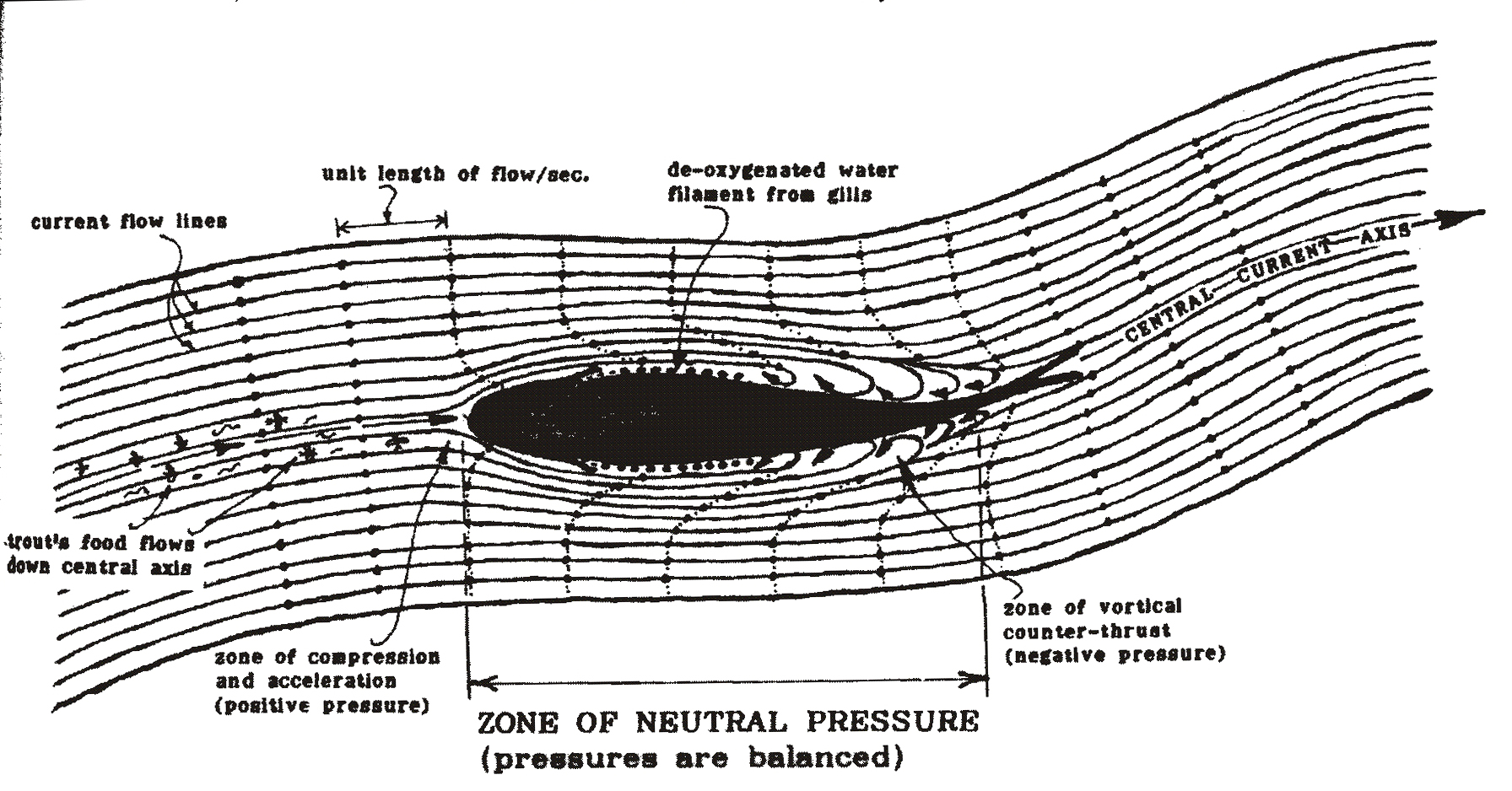
|
| Fig. Fs04. (taken from book Living Energies by Callum Coats; used with permission) |
As
previously discussed, most stationary objects in flowing water generate vortices and it looks like a trout does as well. What is interesting to note here, is that due to the shape of the trout, the vortices
start to form along the rear of its body. Viktor Schauberger explains (this is my simplified version) that the pressure of
the vortices pushes the trout upstream, much like squeezing a wet bar of soap. By opening its gills the trout can increase
the intensity of the vortices it generates, and hence how much energy it can extract. In essence the trout can remain almost
stationary in the flowing water with just a gentle sway to keep itself aligned with the flow. This is sheer genius, but it
gets better.
As
far as I can tell from over a year of studying the leading research in this area, the latest understanding of a trout holding
its position in flowing water, is based on two general scenarios, both characterised by a swaying movement:
a)
A trout holding its position, in flowing water (that doesn’t have any vortices to exploit), can create vortices itself
and remain almost motionless in the flowing water apart from a gentle sway to align itself with the flow of the water.
b)
A trout holding its position, in flowing water behind an object that’s making vortices (a vortex street), slaloms between
the vortices with a much more pronounced swaying movement which is synchronised to the flow and frequency of the vortices.
Although
it appears that everyone agrees ‘one way or another’ that the trout exploits the vortices to hold its position;
to me that doesn’t explain the rest of its movements like moving forward and darting away with such speed. Nor does
any of the research I can find, explain how the trout extracts energy from the vortices… which is fundamental
to understanding how it swims.
So
how does the trout swim?
At
the time of writing (early 2007), the commonly held view in resources like the wikipedia, most encyclopaedias and some of the research papers, appears to be that the tail is the main thruster.
They explain that the backward force of the tail flapping against the water, in conjunction with the fins, moves the fish
forward.
I
believe this view is confusing cause and effect, I think that whilst flapping its tail may be one of its techniques,
(and may be part of the thrust generating process) it’s not the most impressive, the most important, or the most powerful
one: I think that it’s a result of the real technique that the trout uses to extract the energy from the vortices. I think that as the trout slaloms between the vortices with its body and tail weaving
from side to side – it’s not that the tail is generating the main thrust, it’s that the tail is flapping
from side to side as the trout weaves through the vortices to extract energy – first to the right, then to the left
and so on… much like a cat weaving between your legs.
This
seems to be supported by several research papers including the very comprehensive work of James C. Liao which reveals that a trout can hold its position in a vortex street without
using any of its thrusting muscles! Apparently it only starts to use its
thrusting tail fin muscles when the vortex street becomes too weak to provide it with enough energy to fight the current. Even more startling results were obtained with experiments with a dead trout. It was
tethered on a line to an object in flowing water and even though it was dead, it still adopted a swaying movement in the vortex
street and was actually drawn upstream!
It
seems clear from the evidence that the trout extracts energy from the vortices and I believe that this is the main technique
it uses to swim. Using the example of a trout holding its position in flowing
water (where there are no existing vortices to exploit) as discussed, the trout uses the combination of its body shape and
its gills to create and intensify vortices forming against the rear part of its body, I believe it only needs to sway gently
from side to side or open its gills slightly, to further intensify the vortices, extract more energy and move forward.
When
it wants to move away quickly, it opens its gills and also makes a sharp, energetic sideways twist of its body so that it
forms into a near semicircle. This causes more of an in-rush and a powerful vortex is generated that the trout extracts energy
from and shoots away. So in this scenario, the sharp twisting movement causes
a flap of the tail but it’s not the tail that powers it away so quickly (although it may have some thrusting input),
it’s the vortex. Somehow…
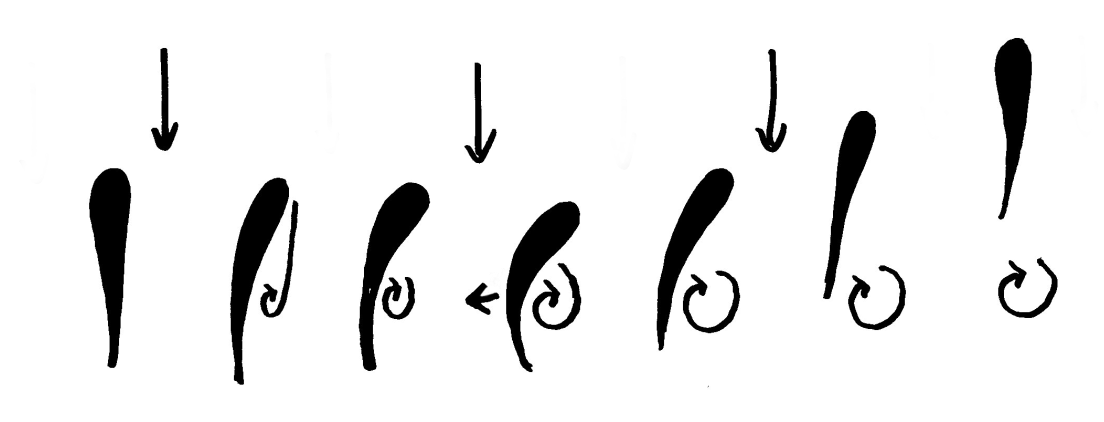
|
| Fig. Fs05. Note the motion of the trouts body; increasing the intensity of the vortex. |
An intriguing hypothesis maybe, but to be able to exploit vortices to this degree the trout would need an extremely
well developed way of detecting them, one that allows it to detect them with lightning speed, either ones that already exist
in the water, or those that it generates itself. And that’s exactly what it does have. It’s well established
that fish have a ‘lateral line system’ that runs down the side of their body. It allows them to ‘see’
even minute changes in water pressure. James C. Liao’s research shows that in conjunction with its eyes, trout use their
lateral line to seek out vortex streets.
Armed with the ability to sense vortices in the water and to extract energy from them, the trout is capable of darting
upstream catching a free ride from spinning vortices along the way. I call it the ‘pinball effect’.
The Pinball
Effect..
So this is the final
part of my hypothesis. I don’t have the resources to prove it, I’m hoping that other like-minded people will be
able to help investigate further, but if I’m right, this is very important stuff.
For me the major question
is still “how does the trout extract energy from the vortices?” and here’s how I think it does it.
If you’ve ever handled
a fish you’ll know that stroking it one way it’s like stroking silk, the other way is like stroking a cheese grater
the wrong way, this is of course because of the fish scales. The scales offer a protective covering so flexible and effective
that it was adopted by humans centuries ago to make suits of armour. The scales also offer the fish an excellent form
of camouflage but as is nature’s way, things always have multiple purposes and I believe they have another, very important
function.
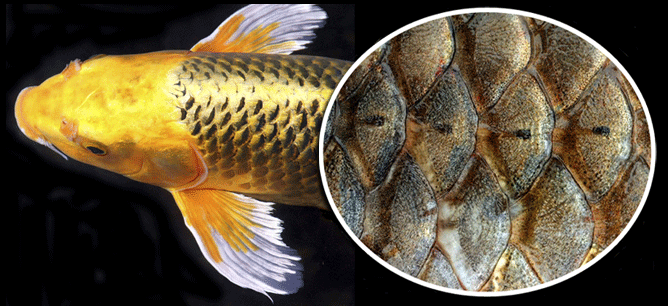
|
| Fig. Fs06. I think fish scales have a very important use other than for protection or camouflage |
The
scales create a ‘one way surface’. As the water flows past the trout
from its snout at the front, to the tail at the back, there is almost zero friction as it passes the shiny, slippery scales (which are also covered by a slime excreted by the trout). If the water were to flow from the back to the front however, it would encounter massive friction as it
catches under the scales, each one acting as a tiny ‘sail’ for the flowing water.
If
one looks again at the direction of the vortices that the trout slaloms between, you’ll notice that as the trout presses
itself against the vortex, the water flowing along the rear of its body, is actually flowing upstream. You’ll also notice that in all cases of swimming in a vortex street, the trout lines itself up this
way. This is also true for the water revolving in vortices that the trout creates with its own body, again, it’s revolving
upstream against the rear part of the fish. The trout extracts energy from the vortex much like a sailing boat does from the
wind.
As
the trout curves its body around the vortex, it has the effect of opening up the scales to capture more energy from the vortex
which translates directly into forward thrust. The trout may also use its fins to capture upstream water flows and it may
use its tail to provide some thrust but overall, I believe that the main tool is its body with a simple ‘one way’
scaled surface that offers ultra-low friction one way, and massive friction the other.
|
|
| Fig. Fs07. scales offer resistance to upstream flowing water as the trout curves round the vortex |
So,
all the fish has to do to remain in position in a vortex street, is to gently ride the vortices, gently swaying from one side
to the other curling round to catch each of the vortices and have them run down the side of their bodies and push them upstream
as in the diagrams.
Simple,
elegant and very efficient. When it wants to dart away, it chooses upstream because
it’s easier to form a strong vortex against the current. A sharp twist in the water and it spins itself away upstream
to either create another vortex itself or hop a free ride from others it can sense in the water... The pinball effect.
It
has taken a couple of years but finally I understand Viktor Schauberger’s comment that has stuck in my mind ever since
I read it: “fish don’t’ swim, they’re swum”
Zero Friction?
The
lessons we can learn from fish don’t stop here.
In
the research paper “An Efficient Swimming Machine”, there is mention of the British Zoologist James Gray who created a stir in
1934 by calculating the power a dolphin would need to swim at 20 knots. The inescapable conclusion apparently, (based on calculations
of rigid model dolphin) was that a real dolphin was ‘technically too weak’; it would need some way to reduce its
drag by a factor of about 7 in order to swim at those speeds. Since then there’s
been a lot of research into dolphins and it’s now known that they shed their skin approximately every 2 hours and that
the shedding process helps reduce drag but personally I doubt skin shedding accounts for the reduced drag alone.
Looking
again at the example of the stationary trout: it can be seen that as a result of the vortices that form around the rear of
the trout’s body, a significant percentage of the trout’s overall body surface will have water flowing in the
same direction (i.e. upstream). This can mean zero (and possibly negative) friction for those parts; which in turn
means a very low overall drag factor in relation to its total surface area. I would be very interested to hear from someone
who knows how to make even a rough calculation in this regard.
Although
Dolphins are not fish and don’t have scales, I believe their shape lends itself to create vortices around the rear of
its body, just like a trout and hence significantly reduce its drag factor. It’s a sublime and elegant solution. If
it’s correct, and a way could be found to use this principal to in the design of ships’ hulls, it could have hugely
beneficial results.
Conclusion
This
has been a mammoth journey of discovery for me. My initial idea was that fish exploit vortices to shoot about in water and
that we could perhaps exploit the techniques a trout uses for our own water borne vessels to help reduce our environmental
impact. When I started this topic I had no idea that research had already been done into this area and that it would support
my initial hypothesis.
If
the final part of my hypothesis is correct, for now there are at least two important concepts that might be able to be employed
in the design of ships, I will include them in the Design Suggestions section soon, along with a few rough sketches. However, to make sure the Intellectual Property is in the Public Domain, I’ll state here that the ideas will be based on the shape of the hull
likened to that of the shape of a fish, and a one-way surface akin to the surface of a fish’s body.
Of
course ships are massively bigger than fish (and only partially submerged) and there are lots of things I don’t know,
like if it’s possible to get water to move in a similar way on such a large scale. Also, I understand that in some cases
generating vortices can increase drag. There are other considerations as well like (according to Victor Schauberger),
the way flowing water breaks into a vortex is dependant upon temperature and velocity. Unfortunately, he’s not around
to ask anymore and I don’t know the answer to these things, but someone out there might?
However, the most intriguing thing for me is that as far as I understand things, fluid
dynamics are very similar for both water and air. If you’ve ever stroked
a bird’s feather, you’ll know that one way it’s as smooth as silk, and has very little friction, whereas
the other way, the complete opposite is true. It’s true to say that birds have a similar ‘one way’
surface, and they too, move around in a ‘fluid’. I’ll say right
now that I believe that birds use and generate vortices to fly and to generate lift much like a fish does.
I
was about half way through writing up this topic when I was made aware of a paper “Leading-Edge Vortex Lifts Swifts” which was published in Science in December 2004. It shows how a Swift
generates a vortex at the leading edge if its wing which it uses to generate lift. If you look at the rotation of the vortex,
it to, is pushing the bird ‘upstream’ just like a fish in a vortex street… using the ‘one way’
properties of feathers I propose.
Viktor
Schauberger’s comment in full, is actually: “fish don’t’ swim, they’re swum and birds
don’t fly, they’re flown”.
I’ll
start a “Birds Flying” topic at some point.
|
